Cassidinae
The Cassidinae (tortoise and leaf-mining beetles) are a subfamily of the leaf beetles, or Chrysomelidae. The antennae arise close to each other and some members have the pronotal and elytral edges extended to the side and covering the legs so as to give them the common name of tortoise beetles. Some members, such as in the tribe Hispini, are notable for the spiny outgrowths to the pronotum and elytra.
| Cassidinae | |
|---|---|
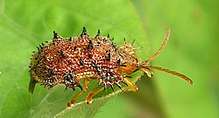 | |
| Platypria sp. | |
| Scientific classification | |
| Kingdom: | Animalia |
| Phylum: | Arthropoda |
| Class: | Insecta |
| Order: | Coleoptera |
| Family: | Chrysomelidae |
| Subfamily: | Cassidinae Gyllenhal, 1813 |
| Tribes[1] | |
| |
Description
The "cassidoids" have a rounded outline with the edges of the pronotum and elytra spreading out to cover the legs and head. They are often colourful and metallic, with the ability to change the colour (and lost in specimens) which is present in the living tissue below the translucent cuticle. All members of the subfamily have the mouthparts reduced into a cavity in the head capsule, the legs have four segmented tarsi. The hispoids have larvae that are leaf miners, while the cassidoids feed on the plant surfaces, sometimes covering their bodies with faecal shields. Although fecal shields are thought to provide defense, no evidence exists for such a role.[2]
A few species in two closely-related tribes (Mesomphaliini and Eugenysini, putative sister taxa) show maternal care of larvae.[3] These species can be viewed as subsocial or parasocial, with evidence pointing to there being two evolutionary origins of subsociality within this one lineage.[4]
Taxonomy
It includes both the former subfamily "Hispinae" (leaf-mining beetles), as well as the former more narrowly defined subfamily Cassidinae (familiar as tortoise beetles) which are now split into several tribes that include the tribe Cassidini, and in all include over 125 genera. The traditional separation of the two groups was based essentially on the habitats of the larvae and the general shapes of the adults. The name Cassidinae for the merged subfamily is considered to have priority.[5]
The former grouping of "Hispinae" (sometimes called leaf-mining beetles, or "hispoids") included the tribes Alurnini, Anisoderini, Aproidini, Arescini, Bothryonopini, Callispini, Callohispini, Cephaloleiini, Chalepini, Colaenomendorini, Cryptonychini, Cubispini, Eurispini, Exothispini, Gonophorini, Hispini, Hispoleptini, Hybosispini, Leptispini, Oediopalpini, Oncocephalini, Promecothecini, Prosopodontini, Sceloenoplini and Spilophorini.[1] Most members of these tribes are elongated, slightly flattened beetles with parallel margins, and antennal bases close together on their small heads. They often have punctate elytra and pronotum, sometimes with spines both on and along the edges. The former grouping of Cassidinae (sometimes called tortoise beetles, or "cassidoids") included the tribes Aspidimorphini, Basiprionotini, Cassidini, Delocraniini, Dorynotini, Eugenysini, Goniocheniini, Hemisphaerotini, Mesomphaliini, Notosacanthini, Omocerini and Physonotini.[1]
The subfamily names Cassidinae and Hispinae are both founded by Gyllenhal in the same 1813 book, but following the Principle of the First Reviser, Chen in this case,[6] priority is given to the name Cassidinae.[5]
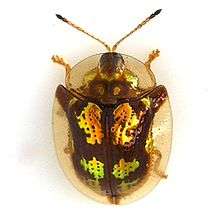 Deloyala guttata, mottled tortoise beetle, showing typical shape and patches of metallic coloration
Deloyala guttata, mottled tortoise beetle, showing typical shape and patches of metallic coloration- Leaf beetle Chalepus sanguinicollis, Grand Cayman
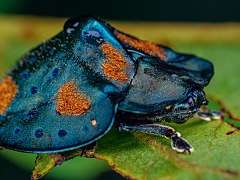 Blue and orange tortoise-beetle Stolas cf. conspersa from Brazil
Blue and orange tortoise-beetle Stolas cf. conspersa from Brazil.jpg) Stolas lebasii, Panama
Stolas lebasii, Panama_2.jpg) Stolas lebasii, Panama
Stolas lebasii, Panama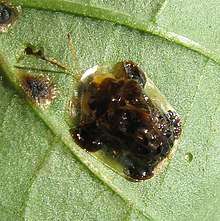 Plagiometriona clavata
Plagiometriona clavata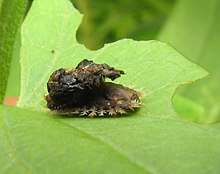 Charidotella sexpunctata, larva protected by fecal shield
Charidotella sexpunctata, larva protected by fecal shield Charidotella sexpunctata, adult
Charidotella sexpunctata, adult
See also
References
- Borowiec, L.; Świętojańska, J. 2014: 2.7.2 Cassidinae Gyllenhal, 1813. Pp. 198-217 in: Leschen et al., 2014
- Bottcher, A; Jorge Paulo Zolin; Flávia Nogueira-de-Sá; José Roberto Trigo (2009). "Faecal shield chemical defence is not important in larvae of the tortoise beetle Chelymorpha reimoseri (Chrysomelidae: Cassidinae: Stolaini)". Chemoecology. 19 (1): 63–66. doi:10.1007/s00049-009-0006-x.
- Flowers, RW (2008). "Leaf beetles (Coleoptera: Chrysomelidae)". In Capinera, JL (ed.). Encyclopedia of Entomology (2 ed.). Springer. p. 2148.
- Leocadio, Michele; Sekarka, Lukas; Simoes, Marianna; Shrago. "Molecular systematics reveals the origins of subsociality in tortoise beetles (Coleoptera, Chrysomelidae, Cassidinae): Evolution of subsociality in Cassidinae". Systemic Entomology. Royal Entomoogical Society. Unknown parameter
|first 4=ignored (help) - Chaboo, CS (2007). "Biology and phylogeny of the Cassidinae Gyllenhal sensu lato (tortoise and leaf-mining beetles) (Coleoptera: Chrysomelidae)". Bulletin of the American Museum of Natural History. 305: 1–250. doi:10.1206/0003-0090(2007)305[1:BAPOTC]2.0.CO;2.
- Chen, S. H. (1940). "Attempt at a new classification of the leaf beetles". Sinensia. 11: 451–481.